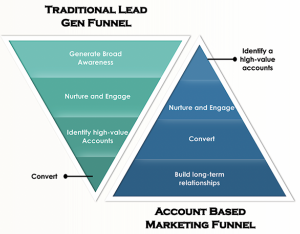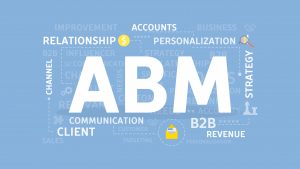How is your audience engagement? Are you wasting a lot of time and resources on marketing? Are your returns on new customers worth the initial effort? If you’re unsure about any of these questions, account-based marketing (ABM) might be able to help!
What is Account-Based Marketing?
A juicy burger and an ice-cold beer is a killer combination, right? Well, account-based marketing is another effective combination of “flavors” or elements. This element combination is made up of aligned marketing and sales growth strategies that work together to create customers out of predefined, targeted accounts within a market.
ABM uses personalized marketing campaigns to engage each targeted account, basing the campaign on the account’s attributes and needs, similar to the way personal trainers tailor workouts to their clients’ body types and goals. ABM is quickly becoming the standard marketing practice for B2B companies targeting larger accounts. Commonly used ABM marketing tactics include:
- Events
- Webinars
- Direct Mail
- Email Campaigns
- Paid Advertising
- Web Personalization
Traditional Marketing
Traditional marketing functions like throwing a handful of darts at a dartboard and hoping to hit a bullseye. This approach to lead generation is designed to capture as many leads as possible, often leading to wasted time, effort and funds on people who never become customers.
 Look at this model as a funnel. At the top of this traditional model, we have lots of lead interest. Once the leads are personalized and engaged through whatever marketing strategy is used, they can be identified and secured as customers. The end of the funnel is where the difficulty to secure the customers lies because it might not work between parties for whatever reason.
Look at this model as a funnel. At the top of this traditional model, we have lots of lead interest. Once the leads are personalized and engaged through whatever marketing strategy is used, they can be identified and secured as customers. The end of the funnel is where the difficulty to secure the customers lies because it might not work between parties for whatever reason.
According to Forrester Research, over 99% of leads generated using the traditional method never become customers! Well, because not all companies are created equal. Some may not be able to afford the product or service being marketed. Some may not be within the right geographical region. Some may not be in the intended industry. Then, there will always be companies not interested at all. Like someone speed swiping through Tinder looking for a future fiancé, it’s quite easy to see how money, effort and resources could be exhausted using this model.
How is ABM Different?
For ABM, let’s use the same funnel analogy, except let’s turn the funnel upside down. Now, instead of trying to get anyone and everyone as customers, companies choose who they want to identify first. Doing this gives you a narrow scope where all of your efforts can be focused on specific accounts. Targeting the right accounts for your business can be difficult. Some simple identifiers to get off on the right foot can include high yield, product fit, quick wins, strategic importance and scale.
ABM basically functions as a search engine does. You tell it what and who you want to target and it gives you a campaign suited for those specified. This model directs 100% of the allocated money and resources to those targeted accounts, dramatically cutting down on wasted funds as less-valuable companies are filtered out early on. Going beyond lead generation, ABM works to encourage upselling and cross-selling with existing clients leading to future opportunities and getting the most value from large accounts.
ABM requires increased effort and personalization to better serve these hand-picked customers. The sales and marketing teams will need to agree on resources, personnel, roles and responsibilities to do so. The transitions between activities and measuring campaign success need to be seamless so these teams need to be able to quickly jump in and assist with the critical process of engaging and satisfying the accounts. However, effort and hard work pay off. The benefits of implementing ABM include:
- Driving attributed revenue

- Generation of more conversations and quality leads
- A personalized marketing approach
- Sales and marketing alignment
- Shorter sales cycles
- A clear return on investment
- Fewer wasted resources
- Increased customer loyalty
- Expansion opportunity through account relationships
Times are changing. 71% of B2B organizations are testing or currently using ABM; 92% of companies recognize its value and call it a B2B must-have. Don’t get left behind.
If you’re looking to develop a marketing strategy for your business, contact us anytime!
